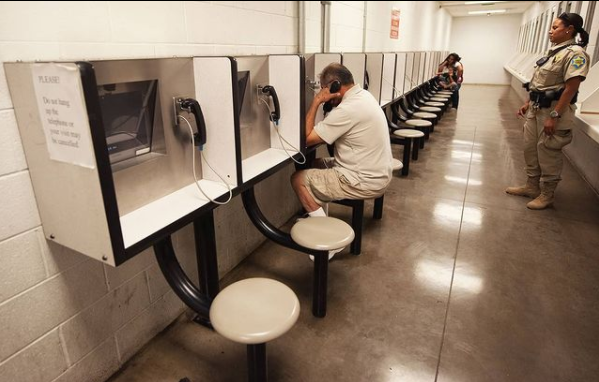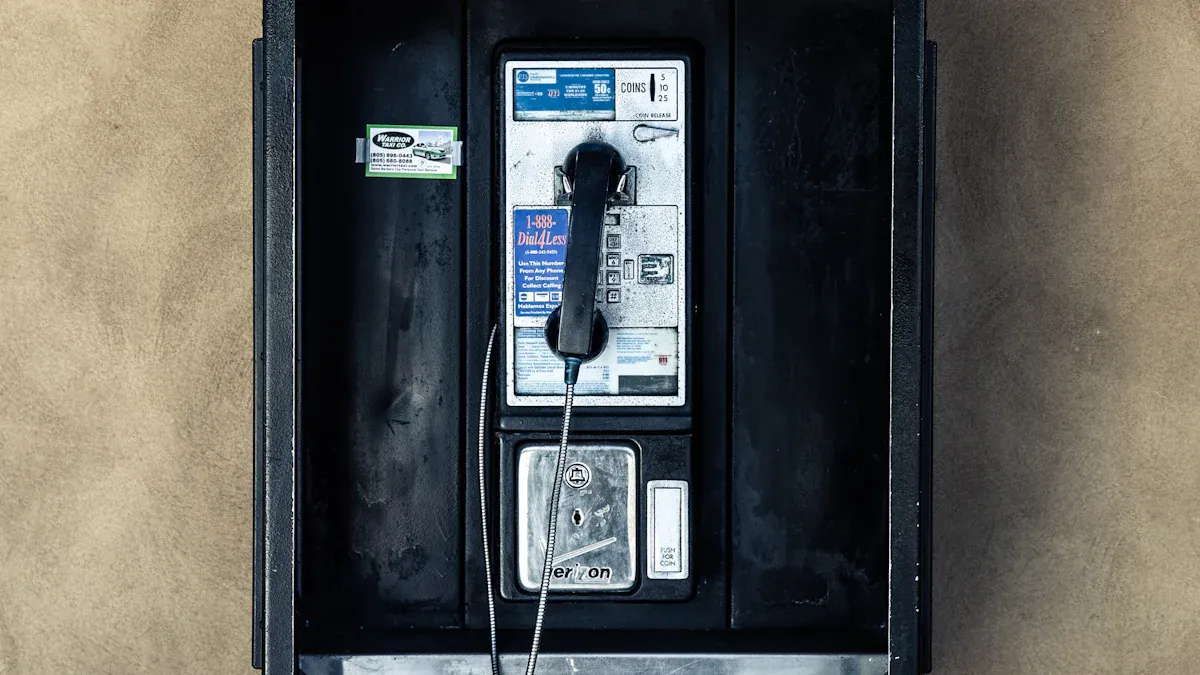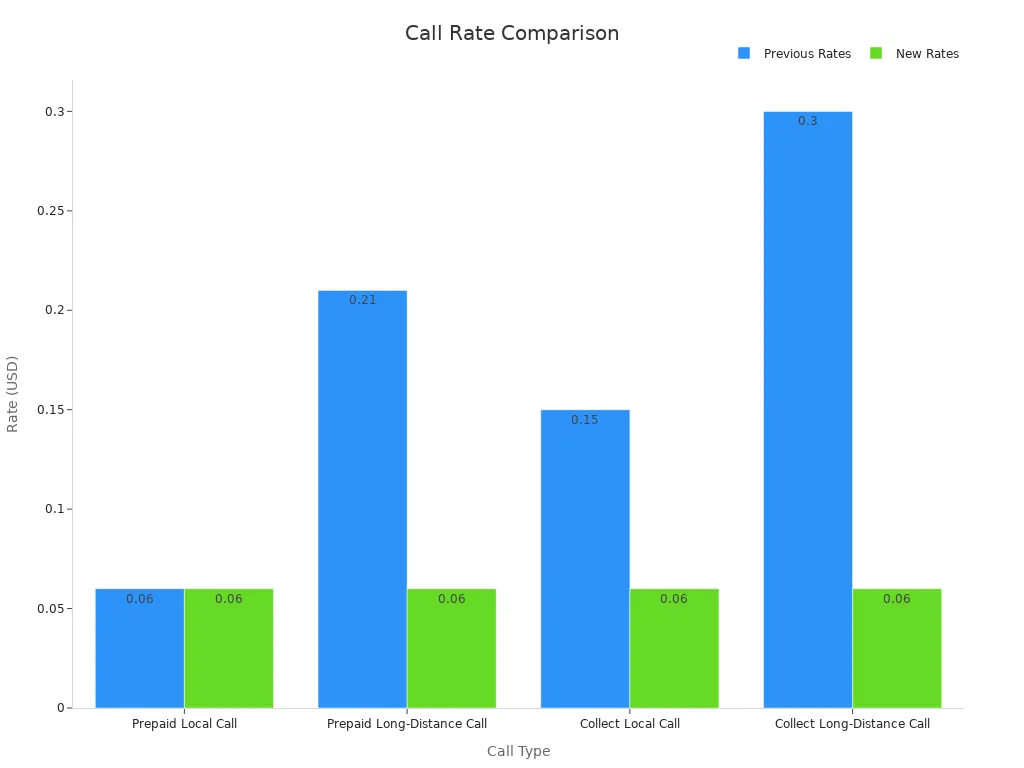
Effective communication plays a vital role in the rehabilitation and reintegration of inmates. Without reliable tools, inmates struggle to maintain connections with loved ones and legal representatives. The introduction of the jail telephone handset has revolutionized prison communication systems. For instance:
- The number of phone call users doubled after in-cell telephony became available.
- Calls made quadrupled, with over 34,000 inmates now utilizing this resource.
- In France, 52,000 in-cell phones ensure 100% coverage across all prisons.
Yet, many inmates still face barriers. Limited written communication hampers their connection to the outside world, and strict regulations often restrict access to legal counsel.
The COVID-19 pandemic further underscored the importance of accessible communication, as face-to-face interactions became nearly impossible.
Key Takeaways
- Jail phones help inmates talk to family and lawyers easily.
- Lower call costs make it cheaper for families to stay in touch.
- Regular calls with family help inmates improve and avoid reoffending.
Challenges in Prison Communication
Limited access to communication tools
Incarcerated individuals often face significant barriers to communication due to limited access to modern tools. Many prisons restrict the use of internet-based technologies, leaving inmates reliant on outdated systems. A study conducted in the U.K. revealed that while some facilities trialed Skype visits, access remained minimal.
The research highlighted both interest and fear of technology among prisoners, emphasizing the need for better communication tools to support reintegration into society.
Additionally, incarcerated individuals are frequently excluded from research opportunities due to strict regulations. This exclusion limits scientific advancements and prevents the development of effective communication solutions.
- Incarcerated students face censorship policies that restrict access to educational resources.
- Technology access in prison programs often lags behind that of home campuses.
- Experts recommend improving communication tools and support services for incarcerated individuals.
Financial burdens on inmates and families
The cost of maintaining communication with incarcerated loved ones places a heavy financial burden on families. Phone calls from correctional facilities can cost families between $50 to $100 monthly. Many inmates come from low-income backgrounds, with two-thirds reporting an annual income of less than $12,000 before incarceration.
Families often struggle to meet basic needs due to these expenses. Approximately 65% of families with an incarcerated member face financial hardship, with an average debt of $13,000. For 58% of families living in poverty, the costs associated with communication and visitation are unaffordable.
Security risks and contraband issues
Deficiencies in prison communication systems contribute to security risks and the prevalence of contraband. Outdated detection technologies fail to address modern threats, such as drones used to smuggle illicit items.
- Contraband cell phones remain a significant concern, posing threats to institutional safety.
- Over half of incarcerated individuals meet criteria for drug dependence, increasing demand for contraband.
- Experts stress the need for improved training and resources for correctional staff to combat these challenges effectively.
These issues highlight the urgent need for modernized communication systems in correctional facilities.
The Role of Jail Telephone Handsets in Modern Systems

Enhancing accessibility for inmates
Jail telephone handsets have significantly improved accessibility for incarcerated individuals. These devices provide a reliable means of communication, allowing inmates to maintain contact with family members, legal representatives, and support networks. Unlike traditional systems, which often limit access to shared phones in common areas, modern handsets offer greater availability. In some facilities, in-cell telephony ensures that inmates can make calls without waiting in long queues or adhering to restrictive schedules.
This increased accessibility fosters a sense of connection to the outside world. It also reduces the stress associated with limited communication opportunities. By bridging the gap between inmates and their loved ones, jail telephone handsets play a crucial role in supporting emotional well-being and social reintegration.
Advanced security features to prevent misuse
Modern jail telephone handsets incorporate advanced security features to address concerns about misuse. These systems are designed to prevent unauthorized activities, such as planning illegal operations or smuggling contraband. Features like call monitoring, voice recognition, and keyword detection enable authorities to identify and mitigate potential threats.
Additionally, these handsets often include restrictions on call durations and approved contact lists. This ensures that inmates can only communicate with verified individuals. By integrating these safeguards, correctional facilities can maintain a balance between providing communication access and ensuring institutional security.
Security measures also help reduce the prevalence of contraband cell phones, which pose significant risks to both staff and inmates. With robust monitoring systems in place, jail telephone handsets offer a safer alternative to unauthorized devices.
Cost-effective communication solutions
Jail telephone handsets provide cost-effective communication solutions for inmates and their families. Traditional prison phone systems often impose exorbitant fees, making it difficult for low-income families to stay connected. Modern handsets, however, have introduced more affordable rates, alleviating the financial burden on families.
For example, the cost of a prepaid long-distance call has dropped from $0.21 to $0.06 per minute. Similarly, collect long-distance calls, which previously cost $0.30 per minute, now cost only $0.06. The table below highlights these changes:
| Type of Call | Previous Rate | New Rate |
|---|---|---|
| Prepaid Local Call | $0.06 | $0.06 |
| Prepaid Long-Distance Call | $0.21 | $0.06 |
| Collect Local Call | $0.15 | $0.06 |
| Collect Long-Distance Call | $0.30 | $0.06 |

These reduced rates not only benefit families but also encourage inmates to use authorized communication channels. By making calls more affordable, jail telephone handsets promote consistent communication, which is essential for maintaining relationships and supporting rehabilitation efforts.
Impacts of Jail Telephone Handsets on Inmate Connectivity
Strengthening family and social ties
Maintaining strong family and social connections plays a pivotal role in an inmate’s journey toward rehabilitation. Jail telephone handsets provide a reliable and accessible means for inmates to stay in touch with their loved ones. This consistent communication fosters emotional support and helps inmates maintain a sense of belonging, which is crucial for their reintegration into society.
Studies have shown that family ties significantly reduce recidivism rates and improve post-release outcomes. The table below highlights key findings:
| Study Type | Findings |
|---|---|
| General Communication | Family ties are associated with lower recidivism rates and successful reintegration into society. |
| Family Contact | Inmates maintaining family ties are less likely to adopt criminal behaviors and are more likely to reintegrate successfully. |
| Literature Review | Limited studies exist, but those that do support the positive impact of family ties on post-release success. |
Maintaining family connections also reduces stress for inmates and promotes mental health. Strong family ties contribute to public safety by decreasing recidivism.
By enabling regular communication, jail telephone handsets strengthen these bonds, creating a foundation for successful reintegration and reducing the likelihood of re-offending.
Improving mental health and emotional well-being
Incarceration often leads to feelings of isolation, anxiety, and depression. Jail telephone handsets serve as a lifeline for inmates, allowing them to connect with family members and support networks. These interactions provide emotional reassurance and help alleviate the psychological toll of imprisonment.
Research spanning over five decades highlights the benefits of maintaining contact through phone calls, visitation, and mail. These benefits include improved mental health outcomes for inmates and their families. For example, children of incarcerated parents often perform better academically when they maintain regular contact with their parents.
Regular communication fosters a sense of normalcy and reduces the emotional strain of incarceration. This, in turn, supports inmates’ mental health and prepares them for life after release.
By addressing the emotional needs of inmates, jail telephone handsets contribute to a healthier prison environment and promote overall well-being.
Supporting rehabilitation and reducing recidivism
Rehabilitation is a cornerstone of modern correctional systems, and effective communication plays a critical role in this process. Jail telephone handsets provide inmates with the opportunity to maintain relationships that are essential for their personal development and reintegration.
Experiences from nearly 19 countries demonstrate that improved access to secure telephone communication reduces illegal mobile phone use in prisons. This, combined with better search practices, enhances security and promotes social reintegration. Research also indicates that maintaining family contact during incarceration significantly lowers the chances of re-offending. The federal Bureau of Prisons emphasizes that telephone privileges help sustain community and family ties, which are crucial for an inmate’s rehabilitation.
High prison phone rates have historically hindered communication, contributing to larger prison populations due to increased re-offending. By reducing these costs, jail telephone handsets encourage consistent communication, which supports rehabilitation and decreases recidivism rates.
Benefits for prison management and operational efficiency
Jail telephone handsets not only benefit inmates but also improve prison management and operational efficiency. These devices reduce the demand for contraband cell phones, which pose significant security risks. Advanced security features, such as call monitoring and voice recognition, help authorities detect and prevent unauthorized activities.
Additionally, the availability of in-cell telephony minimizes conflicts among inmates over shared phone access. This creates a more orderly environment and reduces the workload for correctional staff. By streamlining communication processes, jail telephone handsets enhance the overall efficiency of prison operations.
A safer and more efficient prison environment benefits both inmates and staff, fostering a culture of rehabilitation and security.
Jail telephone handsets have transformed inmate connectivity by fostering consistent communication. These tools strengthen family ties, support rehabilitation, and lower recidivism rates. Their advanced features ensure security while promoting accessibility.
Continued innovation and strict regulation in prison communication systems will further enhance their effectiveness, ensuring a balance between connectivity and institutional safety.
FAQ
What are jail telephone handsets, and how do they work?
Jail telephone handsets are secure communication devices for inmates. They allow monitored calls to approved contacts, ensuring safety and compliance with institutional regulations.
How do jail telephone handsets improve inmate rehabilitation?
These devices help inmates maintain family and social connections. Strong relationships foster emotional stability, which supports rehabilitation and reduces the likelihood of re-offending.
Are jail telephone handsets cost-effective for families?
Yes, modern systems have reduced call rates significantly. Families now face fewer financial burdens, making it easier to stay connected with incarcerated loved ones.

